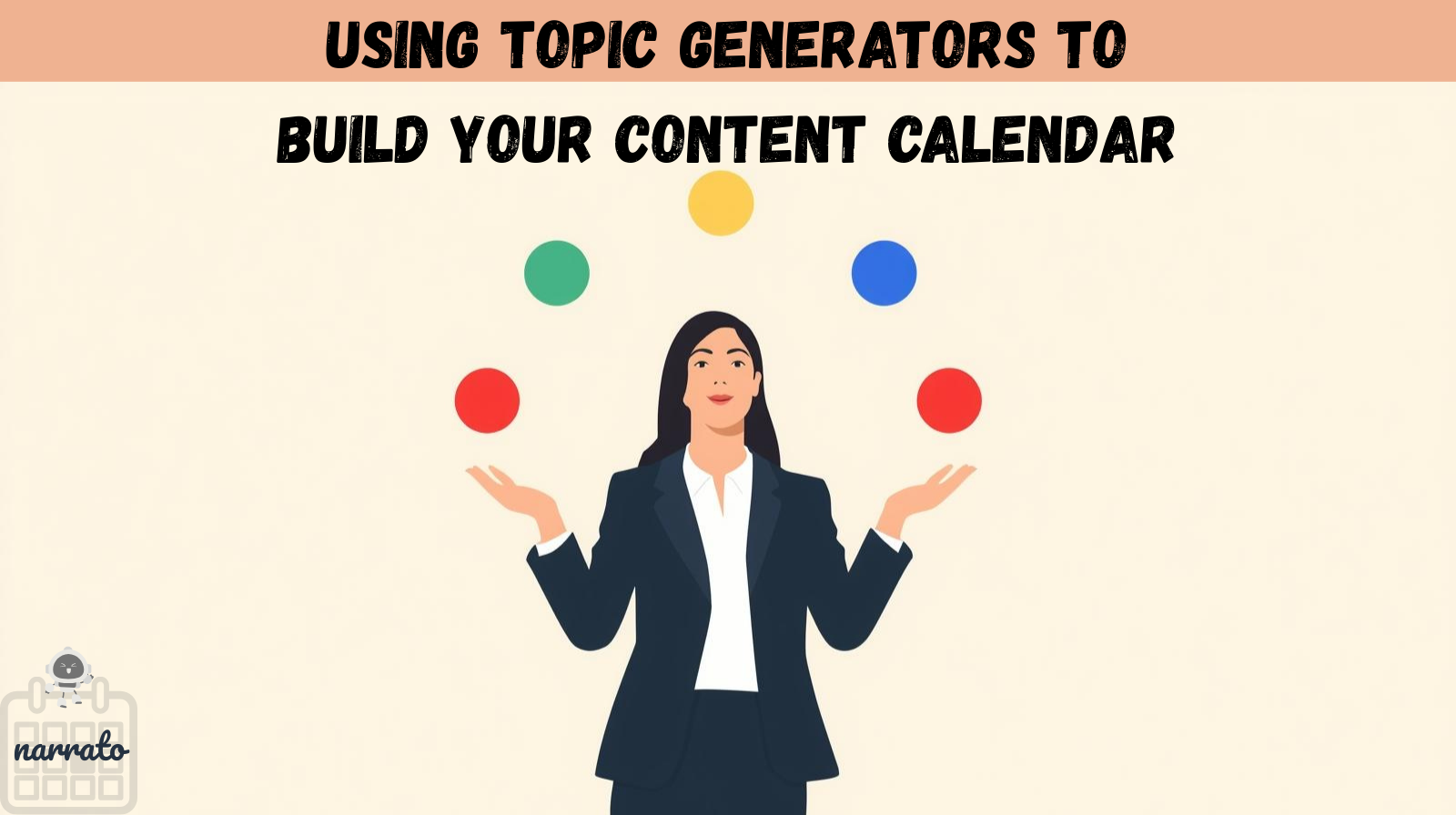A content topic generator is a great brainstorming teammate when you’re planning your content calendar. Spend a few minutes understanding how the AI-powered tool can save you time and set your content strategy into motion. We’ll be talking about our own AI content assistant Narrato here to show how it can make content ideation and workflows efficient.
What is a content topic generator?
Types of content topic generators
Plan your content (with some help from AI)
Build your content calendar

What is a content topic generator?
A content topic generator uses machine learning and natural language processing (NLP) to provide topic suggestions relevant to your keywords or themes. It analyzes datasets from sources like blogs, news articles, and social media to identify patterns (e.g. recurring themes across multiple sources) or popular topics with high overall discussions at any given time.
Not all AI topic generators work this way. Some may rely solely on common content themes in their training data. Either way, an AI idea generator helps you identify content angles you hadn’t thought of and any hidden content gaps you may’ve overlooked. This may explain why 71% of marketers use generative AI to inspire their creative thinking.
Types of content topic generators
What we term a content topic generator can be:
- A tool like Google Autocomplete/Google Suggest, which provides real-time queries based on popular searches and trending topics, among other things
- A feature of an AI content generation platform (e.g. Narrato) that provides multiple topic suggestions for key terms and content themes.
- A keyword-based tool (e.g. AnswerThePublic),which provides content ideas based on keywords
- A social listening tool (e.g. Sprout Social) that monitors social media conversations to identify trending discussions around your brand and products
- Popular forums like Reddit and Quora, where communities gather to discuss, debate, and share their personal experiences
A combination of these different types of content topic generators can help scale your content efforts and be especially useful when creating for multiple sub-brands or clients.
Plan your content (with some help from an AI topic generator)
There’s no one-size-fits-all strategy to planning a content calendar. Use your experience and research to decide what might work best for your product and goals. For example, you may focus on building topical authority, which tells search engines that you’re a trusted resource in your area of expertise. As search engines favor websites that provide helpful content and are recognized authorities in a particular subject, a strategy focusing on demonstrating expertise can improve your search performance and create conversion opportunities on other distribution channels.
Where to start? Decide the topics you’ll cover by establishing 3-5 content pillars.
Start by identifying the core topics to cover in your blogs, whitepapers, social posts, ebooks, videos, infographics, and webinars. Content pillars can provide the framework. A content pillar is a broad theme or topic (pillar) relevant to your industry that can be broken down into sub-topics (clusters). Entity research can help in identifying the topics and subtopics to cover.
Example content pillar-cluster
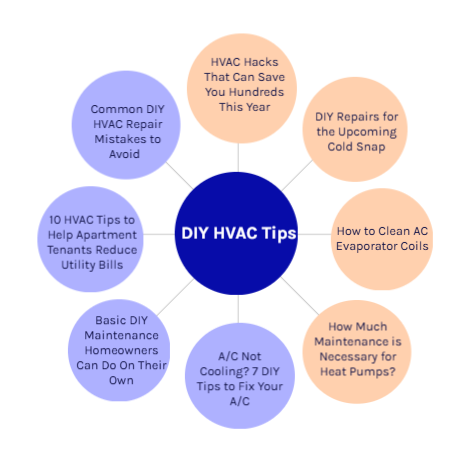
What is entity research?
Google uses entities (people, products, entities, etc.) to understand context and relationships in content. For example, if you sell Apple products, Google must know your website has to do with the technology and not the fruit. So the right phrases and entities to use would be iPhone, smartphone, App Store, iOS, software, etc. (while words connected to the fruit are harvest, nutrition, recipes, fruit juice, and the like).
For the iPhone category, entities include iPhone models (iPhone 16, iPhone 16 Plus, iPhone 15, etc.); accessories (cases, chargers); features (camera, battery, Face ID); technical specs (processor, storage, display); and user actions (setup, troubleshooting). You can even use entity phrases as a starting point for keyword research. For example, the search-intent key terms for iPhone battery might be “improve iPhone battery life” and “iPhone 15 battery replacement cost in UK”.
Tips
- See how people are searching for key terms on People also Ask (PAA), People Also Search for (PASF), Reddit, Quora, Bing, and Medium. Use Narrato’s AI topic generator to get a broader range of topic ideas, then compare them against insights from these sources. Topics that surface repeatedly often signal common or trending queries worth exploring in your content plan.
- Use schema markup, also known as structured data, which helps Google identify the entities and relationships within your content to better judge it comprehensiveness and quality.
Balance different types of content with a content mix
A content mix is a combination of different content topics, formats, and channels to satisfy different audience preferences and reach people at various stages of their buying journey.
- Content formats are the type of media used, such as:
- Text-based content: Blog posts, case studies, ebooks, articles
- Visual content: Images, infographics, social media posts
- Video content: YouTube or social media videos
- Audio content: Podcasts
- Interactive content: Webinars
Match formats to how and where your audience prefers consuming content. Track where your leads and customers come from and focus your content strategy on those channels. For example, an HVAC provider may get better results with SEO blogs or as a community resource in Facebook groups.
- Content topics can broadly fit into these buckets:
- Educational/Helpful: Industry insights, how-to guides, problem-solving content, DIY tips, maintenance guides, troubleshooting, etc.
- Trust-building/Social proof: Case studies, customer stories, thought leadership, local community, behind-the-scenes, etc.
- Promotional: Product announcements, press releases, seasonal offerings, etc.
Create content that helps buyers at each stage of the purchase journey
People have different questions at different stages of their journey from awareness to purchase. Mapping content strategy to each stage or what’s called a content funnel strategy can drive influence throughout the customer journey.
- Top of the funnel (learning about a brand, product, or service) : SEO blogs, social posts, email newsletters
- Middle of the funnel (still researching and evaluating options): Lead magnets, comparison pages, case studies, customer testimonials
- Bottom of the funnel (ready to make a decision): Personalized emails, limited-time offers, webinars, demos, comparison pages
Food for thought: The paths to brand discovery are not linear and not everyone goes through a funnel. People may learn about you during a casual browsing session, through a personal or professional contact, or on another digital/physical touchpoint. Making your content work wherever people can find you helps you become top-of-mind and potentially influences their choice when they’re ready to buy. And when visitors arrive from various touchpoints, they should have a positive browsing experience. Think easy navigation, valuable resources like tips and calculators, social proof through customer stories and reviews, and clear next steps such as newsletter sign-ups, free consultations, or downloadable tools. This is when your content efforts will start paying off.
Build your content calendar
When it comes to documenting topics, Google Sheets is the simplest option. But if you’re looking for smooth workflows and less or no tool-hopping, a project management tool is better. Like Narrato, which teams use to create, collaborate on, and publish content from one platform.
How it works
Create and allocate content items
- Click ‘Content Assistant’ that can be found on the left. You’ll see all of Narrato’s AI use cases. Click ‘AI Topic Generator’.
- Add a theme/keyword for the topic and click on ‘Generate topics’ to get multiple topic recommendations.
- You can edit these topics if you’d like, or simply pick them as is to add to your Project to create new content items. Add more sub-topics under you Project by clicking ‘+New’ above.
- Assign content items to team members. They can view it within ‘My Tasks’ and set status to ‘Drafting’, ‘In Review’, ‘Delivered’, ‘Completed’, and ‘Published’, each having their own color codes.
Give the same process a try to build your social media calendar.
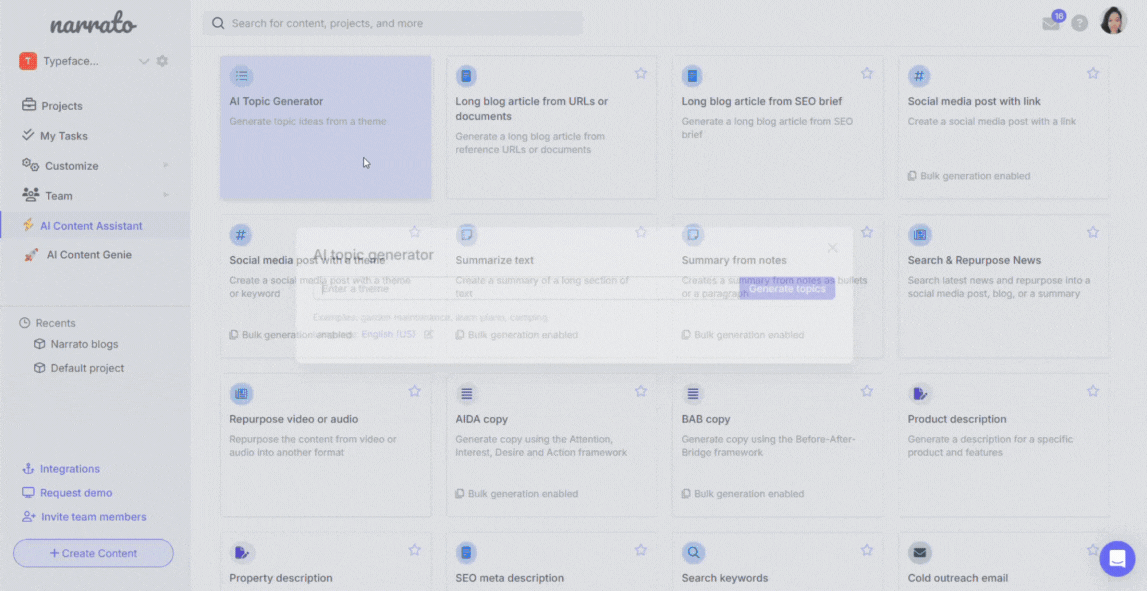

Get your content calendar ready
- If you’ve strict due dates for content items, add one to each in your Project. Everyone can see their tasks and status updates in real time.
- Click on ‘Calendar’ for a visual timeline of the content workflow, from allocation to publication.
- You can even add a content item directly on Calendar by clicking on the desired due date and adding your content topic. It’ll be added to your existing list of content items. This feature offers the flexibility to include breaking news, trending topics, or unexpected opportunities. You could reserve 20-30% of your calendar for such spontaneous content.
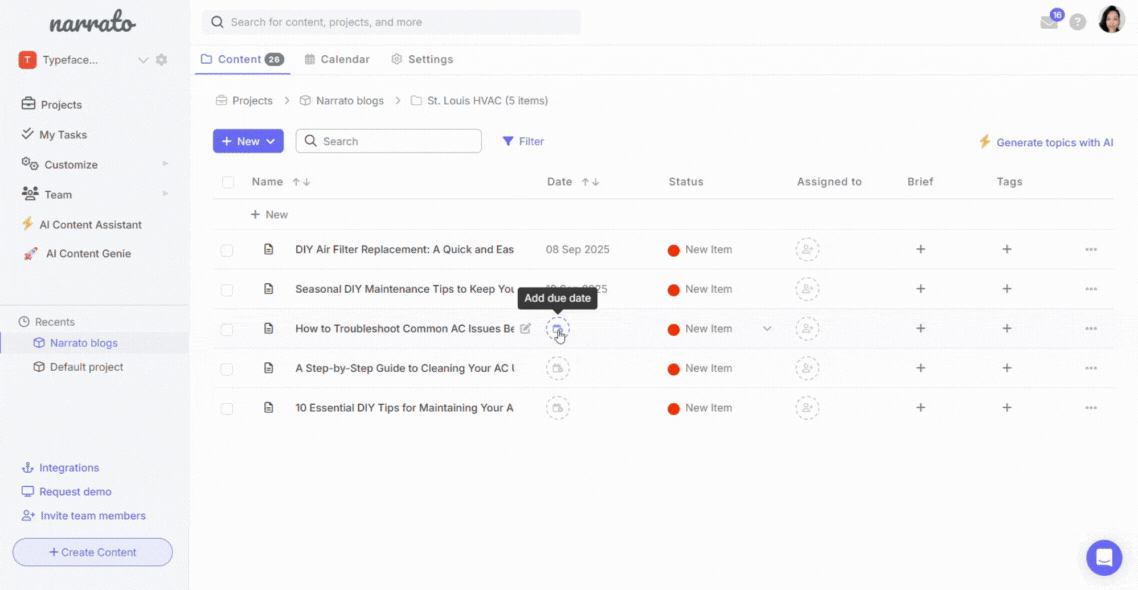

View content progress on calendar
The color coded status of content items appear on the calendar. Clicking on a calendar items takes you to the particular content task on the Narrato workspace.
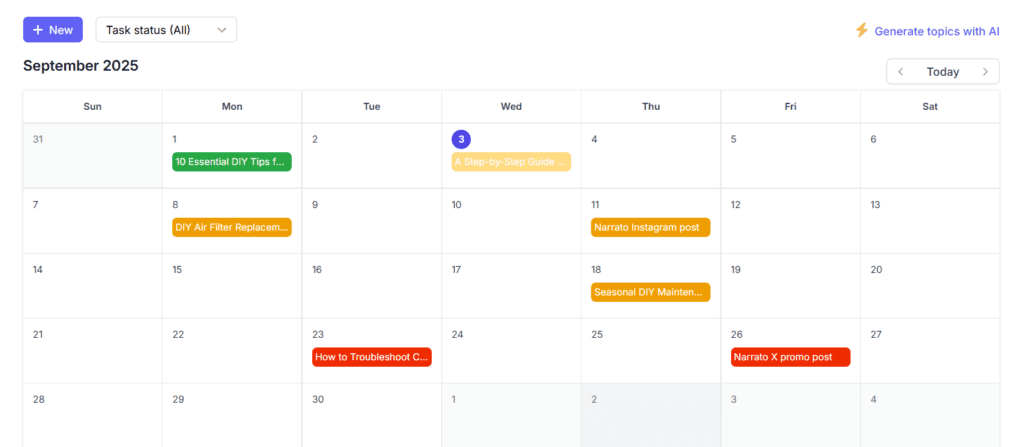

Plan your content calendar easily with an AI idea generator
Content strategies vary based on performance data. When a consistent posting schedule with multiple pieces going out each work keeps leads flowing in, you can use a content idea generator to identify new content angles, beat creative fatigue, or scale content.
Narrato should be on your list, especially if you’re an SMB, freelancer, solopreneur, or small to mid-level agency. Idea generation, content creation, collaboration, and direct publishing, Narrato brings content management on one platform, making life easier for your team.
Why not give us a try? Get your free trial now.



